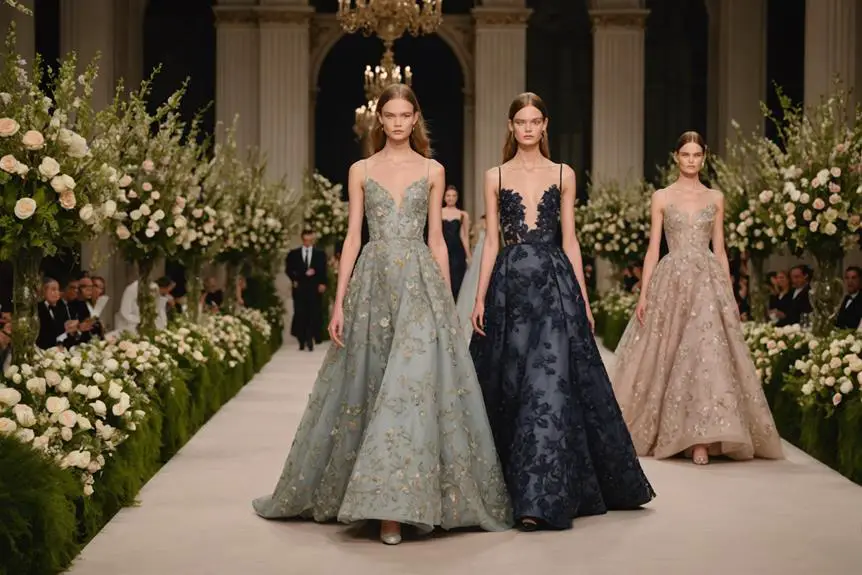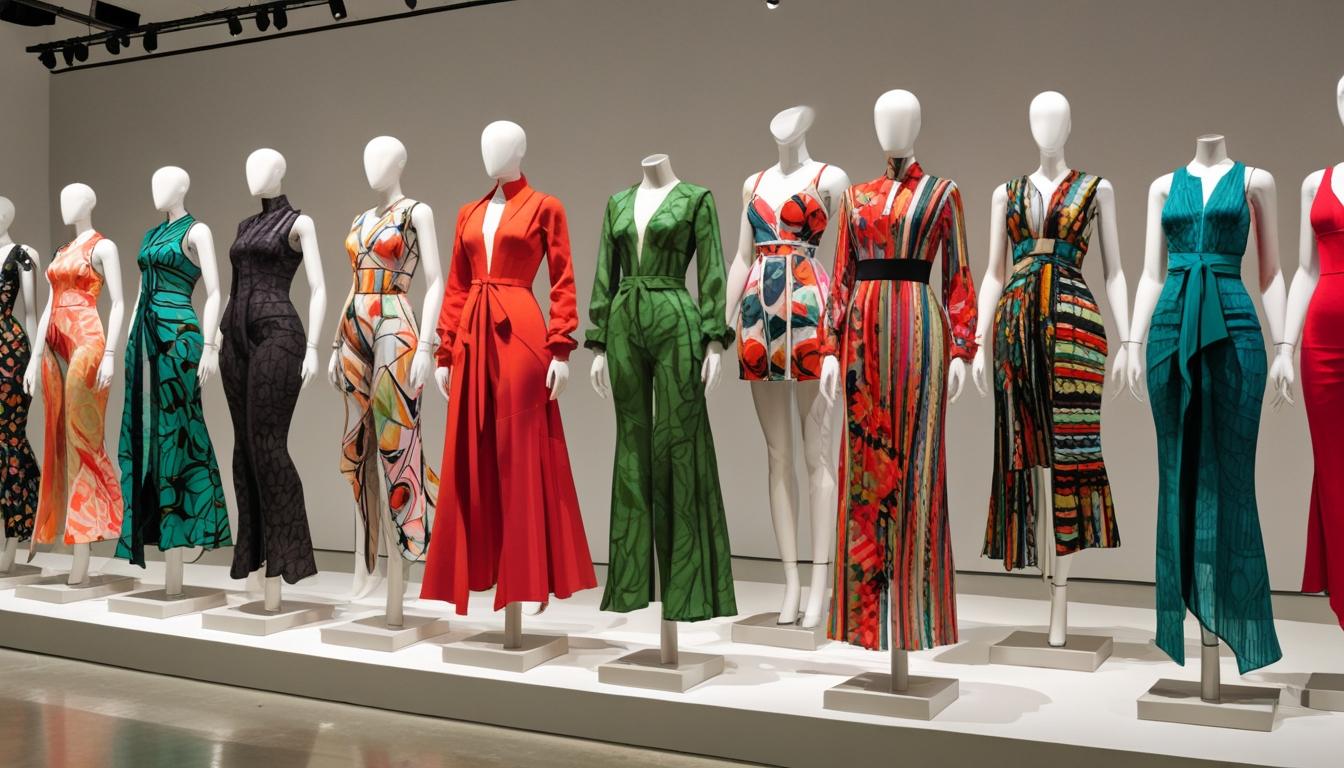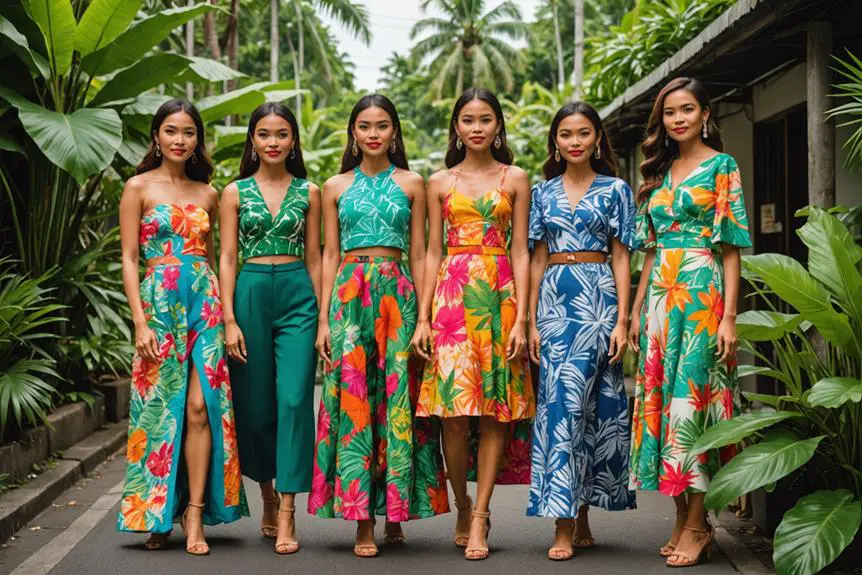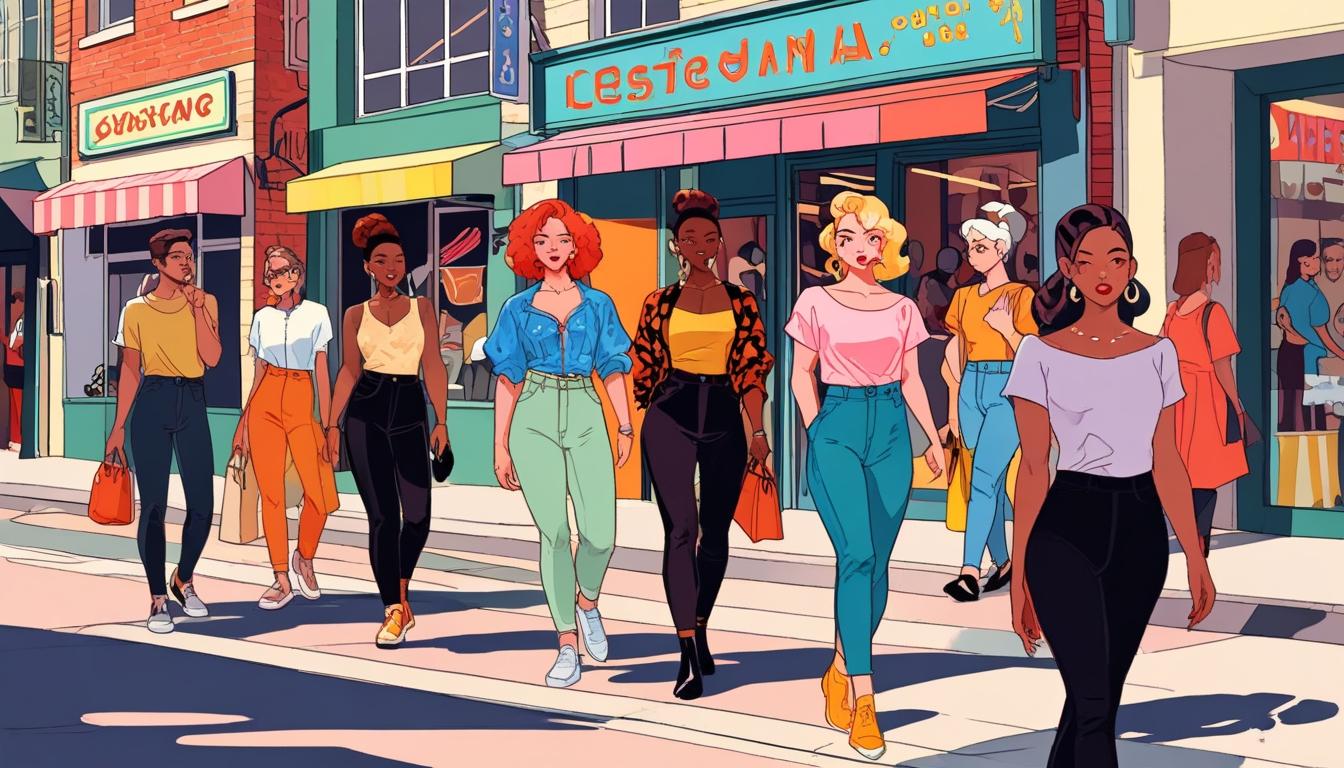When you think of Christian Dior, it's hard not to reflect on those transformative moments that reshaped fashion history. From the 1947 "New Look" that redefined femininity to the bold statements made by Maria Grazia Chiuri, each era reveals a distinct narrative of elegance and empowerment. You might recognize how Princess Margaret's iconic dress turned heads or how Galliano's theatricality pushed boundaries. But what truly lies at the heart of Dior's legacy, and how has each creative director left their mark? The answers might surprise you.
The New Look Revolution
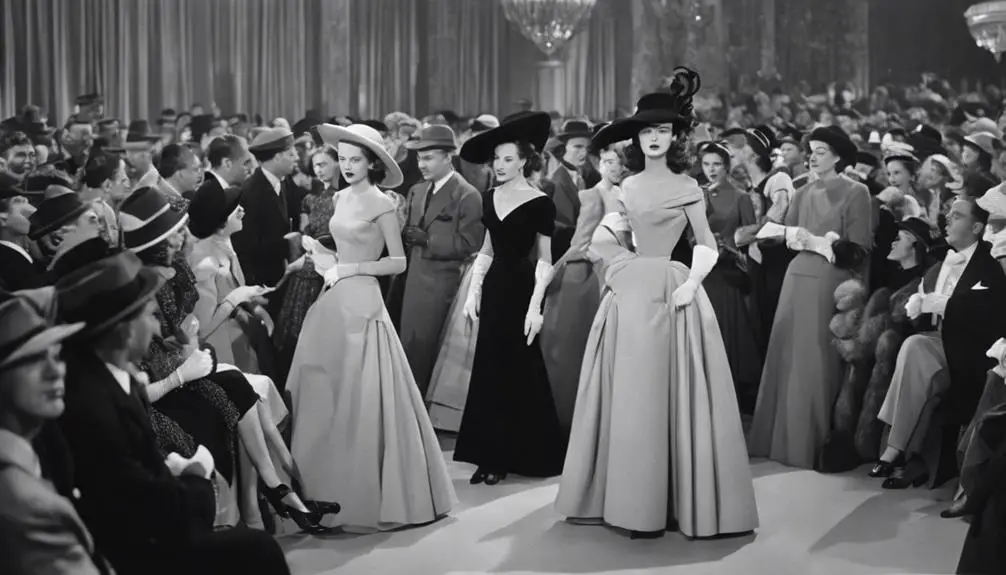
The New Look revolutionized women's fashion in 1947, introducing a striking silhouette that emphasized femininity and luxury. Created by Christian Dior, this groundbreaking collection transformed the post-World War II fashion landscape, moving away from the utilitarian styles that had dominated wartime. With its cinched waists, rounded shoulders, and full skirts, the New Look celebrated the hourglass figure, allowing women to embrace their curves like never before.
One of the most iconic pieces from this collection was the Bar suit, which showcased darted dresses and calf-length skirts. This ensemble didn't just capture attention; it defined an era, establishing Dior as a pioneer in haute couture. The immediate acclaim that followed the New Look's debut marked a significant shift in fashion trends, inspiring designers worldwide to adopt this emphasis on femininity and luxury.
What made the New Look even more remarkable was its ability to evolve. By 1953, variations like the Tulip silhouette emerged, prioritizing a more streamlined design while still maintaining the essence of Dior's original vision. As you explore this era, you'll see how the New Look not only changed individual wardrobes but also influenced societal perceptions of femininity.
Dior's innovative approach left an indelible mark on the fashion world, reminding us that style could be both beautiful and empowering. So, whether you're looking at vintage photographs or modern interpretations, the spirit of the New Look continues to inspire, reflecting a timeless appreciation for elegance and sophistication.
Princess Margaret's Iconic Dress
How did a single dress come to symbolize the elegance of British royalty? The answer lies in Princess Margaret's iconic dress, designed by the legendary Christian Dior for her 21st birthday in 1951. This stunning gown, crafted from silk organza layered over satin, showcased Dior's exquisite craftsmanship and his deep appreciation for British culture. Reflecting the artistry similar to the meticulous designs of vintage Harley Davidson clothing, the gown featured intricate bead detailing, mother-of-pearl accents, and shimmering sequin embroidery, symbolizing quality and timeless style. The dress radiated luxurious details that captured the essence of sophistication.
Photographed by the renowned Cecil Beaton, the dress became immortalized in Princess Margaret's official portrait, solidifying its place in fashion history. It's no wonder Princess Margaret described this gown as her favorite, revealing the emotional connection she felt towards this exquisite design. The dress not only represented a milestone in her life but also marked a significant moment in the collaboration between Dior and the British royal family.
As you admire this iconic dress, you can appreciate how it reflects the glamour and grace associated with royalty. The delicate beauty of the silk organza, combined with the luxurious details, creates an unforgettable image that continues to inspire fashion lovers today. Through this stunning creation, Christian Dior not only dressed a princess but also wove a narrative of elegance that resonates within the fabric of British culture. Indeed, Princess Margaret's iconic dress remains a reflection of the timeless allure of high fashion and its enduring legacy in royal history.
The Tulip Era Redefined
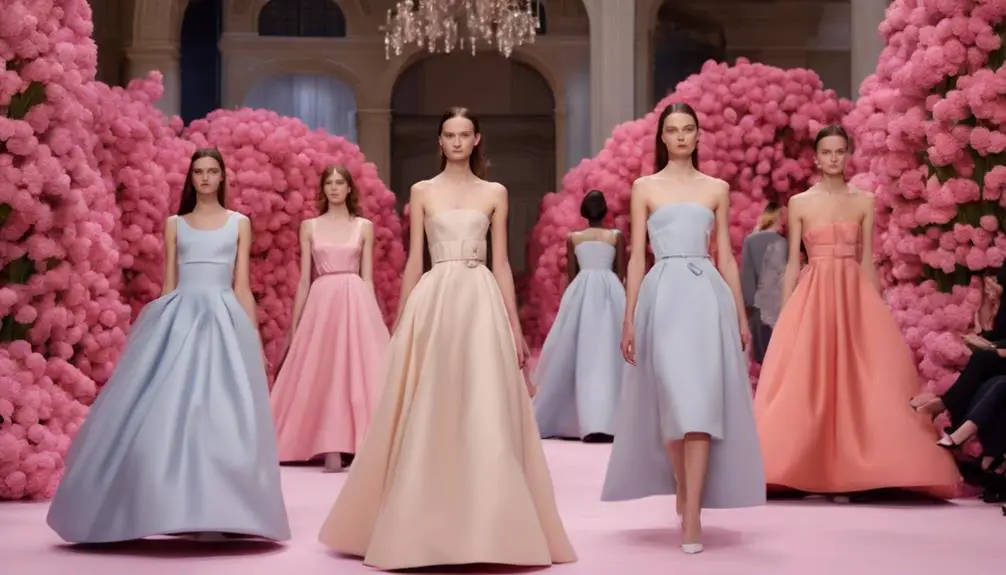
Often celebrated for its transformative approach, the Tulip Era redefined Christian Dior's design philosophy starting in Spring 1953. This pivotal period marked a departure from the voluminous New Look, showcasing streamlined silhouettes that captivated the fashion world. With the introduction of lighter, floaty designs, Dior crafted dresses that emphasized feminine elegance and embraced a more modern aesthetic, appealing to a new generation of women enthusiastic for sophistication without the weight of heavy layers.
The A-line dresses that emerged during the Tulip Era became iconic, enhancing natural curves while providing comfort and ease of movement. These innovative designs allowed women to express their style in a playful yet refined manner, a invigorating shift that resonated deeply with the evolving sensibilities of the time. Floral prints adorned many of these creations, adding a touch of whimsy and vibrancy that perfectly complemented the streamlined silhouettes.
From 1953 until 1955, the Tulip look dominated Dior's collections, capturing the essence of elegance and innovation. Each piece reflected a delicate balance between artistry and wearability, showcasing Dior's ability to adapt to changing fashion landscapes while remaining committed to the timeless ideals of femininity. This era not only redefined the designer's approach but also left a lasting legacy in the world of fashion, reminding us of the power of thoughtful design to uplift and inspire. The Tulip Era remains a tribute to Christian Dior's extraordinary vision, influencing generations of designers and fashion lovers alike.
Marc Bohan's Signature Style
Marc Bohan's signature style at Dior transformed the fashion landscape from 1960 to 1989, emphasizing elegance and timelessness. As the artistic director, you'll find that his vision redefined Dior Haute Couture, bringing forth designs that reflected a modern yet classic aesthetic. Bohan's timeless designs were characterized by streamlined silhouettes and feminine shapes, showcasing the beauty of simplicity while celebrating the female form.
One of his most significant contributions was the introduction of the iconic "Dior Oblique" pattern, which became synonymous with the brand and was embraced across various accessories and collections. His work didn't just stop at haute couture; Bohan expanded Dior's portfolio to include ready-to-wear lines, making luxury fashion more accessible to a wider audience. This move democratized high fashion, allowing more women to experience the exquisite luxury craftsmanship that Dior is famed for.
Bohan understood the importance of versatility in fashion, creating pieces that could effortlessly shift from day to night. His collections resonated with the evolving lifestyles of women in the 1960s and 1970s, allowing them to embrace both elegance and practicality. By marrying luxury with functionality, Bohan's designs became a staple in wardrobes, embodying the spirit of a generation. His impact on Dior remains undeniable, as you can see the lasting influence of his signature style in fashion even today.
John Galliano's Theatrical Designs
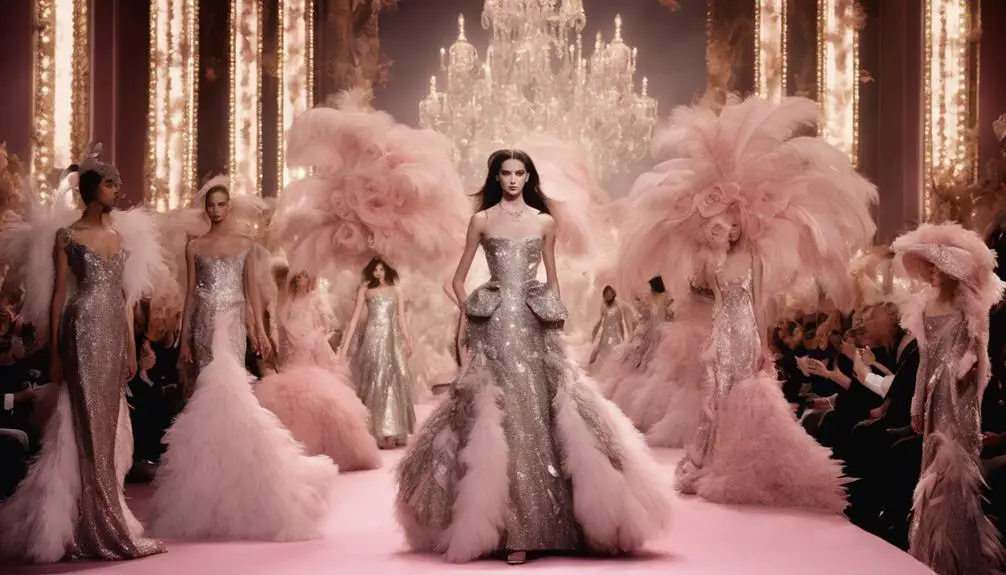
Stepping into the world of John Galliano's theatrical designs at Christian Dior, you encounter a bold fusion of artistry and fashion that redefined luxury in the late 1990s and early 2000s. As the creative director starting in 1996, Galliano introduced a signature style marked by dramatic theatricality and romanticism. His iconic pieces, such as the "Saddle bag" and the newspaper print slip dresses, became synonymous with his innovative approach to couture, transforming high fashion into a narrative art form. This era also marked a resurgence in Christian Dior's prominence, as the brand embraced its rich history while evolving under Galliano's visionary leadership, blending the evolution of Dior's identity with contemporary trends.
In his Spring 2007 collection, Galliano showcased his extraordinary talent for storytelling, enthralling audiences with elaborate runway presentations that felt like theatrical productions. Each gown, embellished with intricate embroideries and decadent fabrics, emphasized the opulence that defined his designs. By revitalizing the "New Look" silhouette, Galliano celebrated femininity and luxury, leaving an indelible mark on Dior's identity and the global fashion landscape.
His collections not only highlighted craftsmanship but also created an emotional connection with viewers, inviting them into a dreamlike world where fashion and fantasy intertwined. Galliano's ability to blend historical references with modern aesthetics made him a revolutionary force in the industry. His designs continue to inspire new generations, proving that fashion is not just about clothing but also about telling stories and evoking feelings. With each piece, Galliano redefined what it means to wear art, ensuring his legacy at Christian Dior remains as iconic as ever.
Maria Grazia Chiuri's Feminist Influence
Following John Galliano's transformative era, Maria Grazia Chiuri stepped into the spotlight as Dior's first female creative director in 2016, heralding a new chapter for the brand. With her debut collection, she boldly introduced the slogan "We should all be feminists," inspired by Nigerian writer Chimamanda Ngozi Adichie's impactful TED Talk. This groundbreaking move not only showcased Chiuri's feminist influence but also established a crucial connection between fashion and activism. By challenging traditional fashion norms, Chiuri drew parallels to the evolution of brand identity seen in other luxury labels.
Incorporating modern narratives into her designs, Chiuri reimagined the classic Dior silhouettes to promote inclusivity and empowerment. Each piece she created served as a canvas for messages that resonated with a contemporary audience, challenging traditional norms within the fashion industry. Her commitment to showcasing diverse models on the runway reinforced the importance of inclusive representation, allowing more voices to be heard and celebrated in a space often criticized for its lack of diversity.
Chiuri's collections sparked conversations about gender equality, encouraging other fashion houses to embrace socially conscious messaging. By championing these themes, she honors Christian Dior's legacy while paving the way for future generations of designers and consumers alike. Her work not only transformed Dior but also inspired the broader fashion landscape to recognize the power of clothing as a tool for social change. Through her visionary approach, Maria Grazia Chiuri has undeniably left an indelible mark on the industry, making her a true icon of modern fashion and feminist thought.
Evolution of Slogan Tees
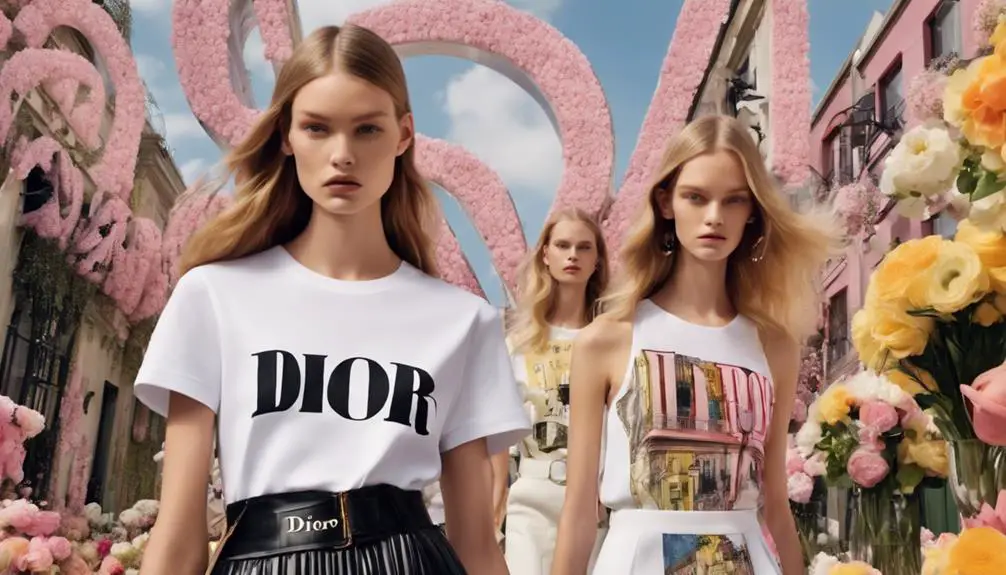
In recent years, slogan tees have emerged as a powerful form of self-expression in the fashion world, capturing attention and sparking dialogue. These tees have transformed into more than just casual wear; they've become a platform for fashion activism and a reflection of the wearer's beliefs. Designers like Maria Grazia Chiuri have played a pivotal role in this evolution, particularly with her debut collection for Dior in 2016, which boldly featured the slogan "We should all be feminists." This phrase, inspired by Chimamanda Ngozi Adichie's TED Talk, marked a significant moment in the domain of socially conscious messaging, similar to how vintage pieces carry their own cultural narratives and history, as seen in identifying vintage Ralph Lauren.
The rise of slogan tees coincides with a broader societal shift towards discussions surrounding gender equality and women's rights. Here's how these tees are making waves:
- Activism in Fashion: They allow wearers to express personal beliefs and engage in meaningful conversations.
- Feminist Themes: Chiuri's influence has inspired other brands to adopt feminist messages, increasing visibility in mainstream fashion.
- Cultural Reflection: Slogan tees address current societal issues, making them relevant and timely.
As you don a slogan tee, you're not just making a fashion statement; you're participating in a movement. Whether you're advocating for gender equality or supporting women's rights, these tees encapsulate the spirit of modern activism, proving that fashion can be both stylish and significant. So, next time you wear a slogan tee, remember it's more than just fabric—it's a voice.
Lasting Impact on Fashion Industry
Christian Dior's influence on the fashion industry is undeniable, shaping trends and standards that persist today. His revolutionary "New Look" in 1947 introduced a silhouette that emphasized a cinched waist and full skirts, setting a new standard for femininity in post-war design. This iconic look not only transformed women's fashion but also inspired countless designers who followed in his footsteps. Fashion houses hold Dior's legacy dear, with talents like Yves Saint Laurent and John Galliano drawing inspiration from his emphasis on elegance and luxury.
Today, under the creative direction of Maria Grazia Chiuri, Dior continues to impact the industry. She's infused feminist themes into the brand's collections, encouraging other designers to engage with social and political issues, thereby reshaping the narrative of luxury fashion. This innovative approach showcases how Dior's legacy evolves while remaining relevant.
One of the most notable examples of Dior's enduring influence is the launch of the "Lady Dior" bag in 1995, which blended high fashion with cultural significance. This accessory became a symbol of luxury and sophistication, further solidifying Dior's status in the luxury market.
Dior's meticulous craftsmanship and innovative design methods have left an indelible mark, as seen in the continued popularity of his collections showcased in exhibitions worldwide. As you explore the domain of fashion today, you'll find that Christian Dior's impact resonates, proving that his iconic looks and principles still guide the industry's evolution.
Frequently Asked Questions
What Was the Most Iconic Dior Look Called?
The most iconic Dior look is the Dior New Look. It's a fashion revolution showcasing timeless elegance with a feminine silhouette. Vintage Dior thrives on celebrity endorsements, influencing haute couture and redefining women's fashion for generations.
What Is Dior's Most Famous Product?
Dior's most famous product is the Lady Dior handbag. Its elegance rivals Dior fragrances, shoes, and accessories, while collaborations enhance its allure. This haute piece often graces Dior runways, symbolizing luxury and timeless fashion.
What Is Christian Dior's Legacy?
Dior's legacy embodies a design philosophy that revolutionized haute couture, promoting feminine empowerment with post-war influences. Celebrity collaborations emphasize timeless elegance while sustainable practices guarantee the brand's influence endures, inspiring future generations in fashion.
Why Was Dior's Fashion Controversial?
Dior's fashion sparked controversy due to its Feminine Revolution, challenging post-war norms. Critics debated haute couture's impact on body image, masculinity in fashion, and cultural appropriation, highlighting broader critiques within the fashion industry.
